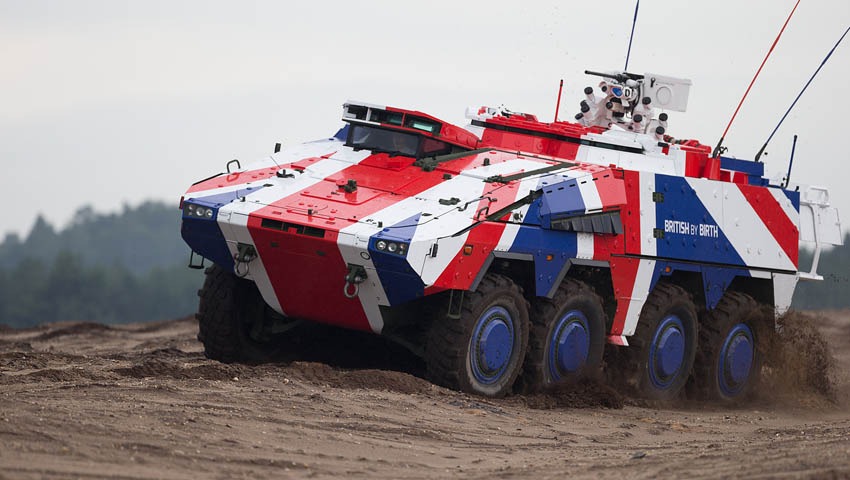The United Kingdom’s Ministry of Defence has announced that it has committed to purchase over 500 Boxer Mechanised Infantry Vehicles for $5.2 billion, with first delivery slated for 2023. The only issue is: that’s the same price Australia is paying for just 211 of the vehicles.
To continue reading the rest of this article, please log in.
Create free account to get unlimited news articles and more!
The UK officially rejoined the Boxer program last year, announcing its intention to explore options to “modernise its vehicle fleet and meet the Army’s Mechanised Infantry Vehicle requirement”.
“Our men and women of the Armed Forces deserve to have the best equipment to do their job,” said UK Defence Secretary Ben Wallace.
“The Boxer vehicle is a leader in its field and I look forward to it arriving in units from 2023.”
The expensive backflip will see the UK receive over 500 of the 8x8 high mobility, network enabled armoured vehicles within four years’ time.
“I am delighted that we have committed to delivering the Mechanised Infantry capability through the purchase of around 500 battle-winning Boxer vehicles for the British Army,” Major General Simon Hamilton, Mechanised Infantry Vehicle Programme lead for the British Army, said about the announcement.
“Boxer completes the suite of platforms to equip our new state-of-the-art STRIKE brigade where, alongside Ajax, Boxer’s low logistic need, extended reach, high mobility, and advanced digitisation will ensure STRIKE is ready for any global scenario.”
Australia chose the Rheinmetall-built vehicle early last year as the recipient of the Land 400 Phase 2 Project tender, with first delivery taking place just over a month ago in Brisbane.
Defence Minister Linda Reynolds said that the new vehicles, with their high levels of protection, firepower and mobility, will provide a world-class capability to the Australian Army.
“These new vehicles are part of the government’s $200 billion investment in our defence capability to ensure the Australian Defence Force is equipped to succeed in our challenging strategic environment,” Minister Reynolds said at a ceremony at Enogggera Barracks in Brisbane in late September.
The federal government estimates that Australian industry will secure about $10.2 billion in acquiring and maintaining the fleet over the 30-year life of the vehicles.
Under the company’s offering to the Commonwealth, Rheinmetall will build a majority of the vehicles at the company’s specialised Military Vehicle Centre of Excellence in Queensland.
A total of 12 small businesses across Australia will contribute to the Boxer program, which defence said is “ensuring the delivery of these vehicles is a national enterprise”.
While the acquisition of the Boxers is a positive for both the ADF and Australian industry, both in advancing capability and boosting the local economy, questions have been asked about the price Australia is shelling out for the MIVs, compared to the UK.
On the face of their announcement, the UK is paying around $10 million per Boxer vehicle, while Australia is paying closer to $25 million a unit.
So why is there such a difference in price?
According to Defence, the simple of it is that the UK’s acquisition is going to cost a lot more than the $5.2 billion they’ve announced.
“Australia’s total acquisition project investment of over $5 billion reflects whole of life costs in addition to each vehicle unit purchase price,” Defence Connect was told by a Defence spokesperson.
“These whole of life costs include facilities, training, support and other project sustainment costs over the full life of the project.”
Assuming the unit price is lowered to the same “aroundabout” cost of $10 million that the United Kingdom is paying, does it really cost more double, per unit, to support the Boxer program?
Well, yes.
Defence has advised in the past that sustainment costs for complex capabilities are usually two to two-and-a-half times the cost of the acquisition, which puts that pricing pretty spot on by itself.
However, Australia’s decision to build the majority of the vehicles locally will also see costs rise, rather than just importing the Boxers.
“The more ‘sovereign’ the support model, the higher the cost,” the Australian Strategic Policy Institute commented (in regards to the F-35 program, but it still holds true for the Boxers).
So just how much will the UK actually pay for the Boxer?
In early 2018, the British Minister for Defence Procurement Guto Bebb said that the program would cost around $8.2 billion for procurement and the first 10 years of support costs.
Applying the same level of price across the 30-year estimated lifespan of the Boxer, that figure rises beyond the $10 billion mark, at least.
Suddenly, the costs begin to align a little more fairly between Australia and the UK.
Digging a little deeper into the UK’s announcement of the purchase, and the reasons for the misleading figures become pretty apparent.
“This contract was signed ahead of the pre-election period due to the strong value-for-money agreement reached with industry and other OCCAR nations, which expires on December 31st 2019, and announced today due to expected market implications. It would be possible for a new government to take a different position,” the release from the British Ministry of Defence read.
“The MOD Permanent Secretary, as the Accounting Officer, considered the value for money implications and, on this basis, determined the most appropriate course of action is to proceed with the contract award ahead of the election.”
With an election coming up, a backflip purchase becomes a lot easier to swallow for the public when it’s presented at less than half its actual cost.

 Login
Login







